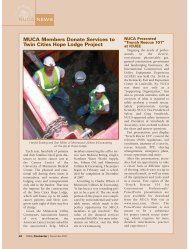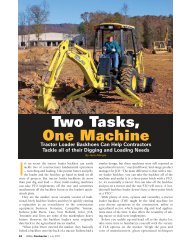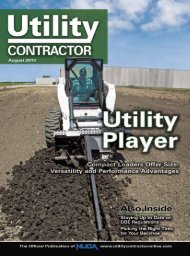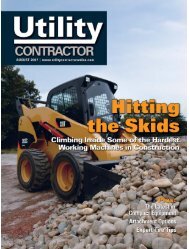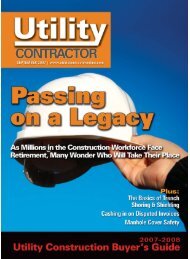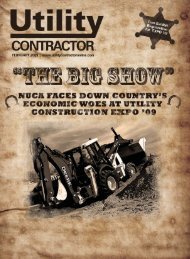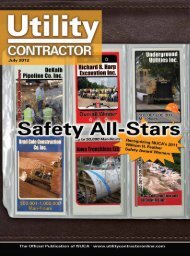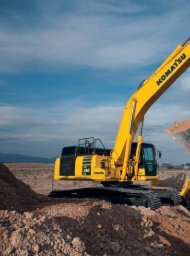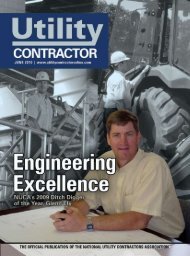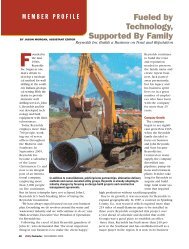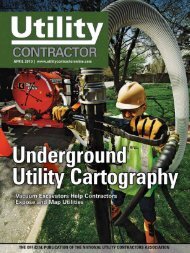View Full July PDF Issue - Utility Contractor Magazine
View Full July PDF Issue - Utility Contractor Magazine
View Full July PDF Issue - Utility Contractor Magazine
- No tags were found...
You also want an ePaper? Increase the reach of your titles
YUMPU automatically turns print PDFs into web optimized ePapers that Google loves.
Trench Shoring Manufacturers Remember Their Toughest JobsExtreme ExcavationsCoble Shores ChallengesBy Steve BarnhardtPipeline Utilities Inc. of Raleigh, N.C., bid for a storm water repairand upgrade project at the University of North Carolina’s BoshamerStadium that involved removing the existing 60-in. pipe and installinga new 72- and 84-in. pipe. In order to successfully complete theproject, Pipeline Utilities would have to excavate to a depth of up to35 ft at the deepest point in poor soil conditions, and they wouldthen be required to lay 300 ft of the new pipe and set three new 14-ftdiameter precast manholes.In addition to the complexity of the actual construction, the projectwould need a fairly complex shoring system. The jobsite conditionsthat would affect the shoring system began with the soil conditions.Soil is often the first variable that directs the use of a protective system.Generally, as soils worsen with depth, they gain additional weight andexert a greater pressure against a protective system. As the soils becomemore granular, they also become prone to raveling. Excessivesoil raveling can prove problematic as a contractor attempts to shorean excavation. While trying to advance the cut of the excavation, thesoil will often just fall in, never allowing you to move your shoringforward. In these types of conditions, your only option is to shore theexcavation continually as you remove the soil.In addition to the poor soil conditions, the depth further complicatedthe issue. Thirty-five ft is a very deep excavation and atthat depth, thousands of pounds per square foot of soil pressurecan be exerted upon the shoring system.The final complicating issue was the large pipe that would needto be installed. For comparative purposes, a standard trench shieldmay yield about 65 in. of vertical pipe clearance under the pipespreaders. The larger of the new pipe being installed would requireup to 102 in. of vertical clearance, clearly in excess of theconventional pipe clearances for most systems.The SolutionCoble Trench Safety Shoring Specialists Brett Sondergard andJohn Knighten met with Pipeline Utilities early in the bid phasefor this project and looked at all parameters surrounding theproject. A plan was put in place with accurate costs that wouldbe needed before the bid. As always, the plan could be subject tochange, but it provided a reasonable approximation of the shoringcost and other costs such as an appropriately sized excavatorto work with the shoring system.“We felt immediately that the slide rail system would easily accommodatethe poor soil conditions we would encounter on thisproject,” says Sondergard. “The slide rail system’s efficiency becomespronounced in bad soils because you can advance the panels alongthe rails ahead of the excavation’s cut, which helps to prevent soilraveling. In addition to helping prevent soil raveling, the system hasthe benefit of being positive shoring. Positive shoring is a systemthat acts to prevent a soil collapse, as opposed to just protectingemployees in the event of a soil collapse, which is typically the roleof a standard trench shield.”In addition, the poor soil conditions exert a greater soil pressureagainst the system. This effect is similar to that of the depthand together they both increase the stress on a slide rail system.The SBH slide rail system is built to handle these intense soilpressures and can comfortably achieve the 35 ft of excavateddepth needed on this project. Large triple slide rails are dug intothe ground, and slide rail panels are advanced along tracks in therail to provide soil protection to the full length of the excavation.During installation, the linear rolling strut is advanced along therail to prevent “toe in” of the system. Once the system is installedto the full depth, the rolling strut can be rolled up to provide additionalvertical clearance as needed. Using site specific engineering,it was possible to achieve the necessary 102 in. of verticalclearance with the site conditions present and ultimately providethe optimal method of shoring the excavation.The steel sheeting guides were needed due to the presence of theexisting lines and are an added benefit to the SBH slide rail system.Steel sheeting guides act as slide rail panels and can be insertedalong the tracks in the slide rail. A sheeting guide is inserted alongthe base of the excavation and at the top of the excavation. The areabetween the sheeting guides remains open and is shored once steelsheets are inserted along grooves in the sheeting guides. The benefitof this design is that the sheets can be inserted around existing lines,which helps to mitigate the effect of crossing existing utility lines.Thanks to a thorough planning phase and attention to detail, theslide rail system was installed without any incidents. The system performedand the contractor was satisfied with the system, as well asCoble Trench Safety’s ability to make such a complex shoring projectflow smoothly from installation through removal.Steve Barnhardt is based in Greensboro, N.C.<strong>July</strong> 2009 | <strong>Utility</strong> <strong>Contractor</strong> 27




